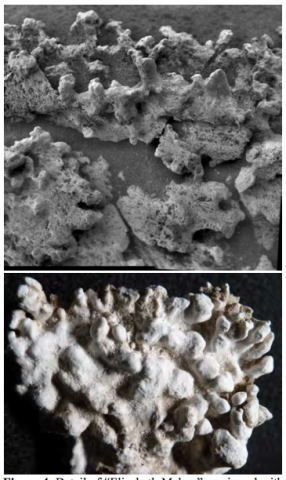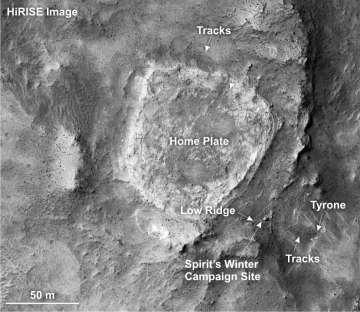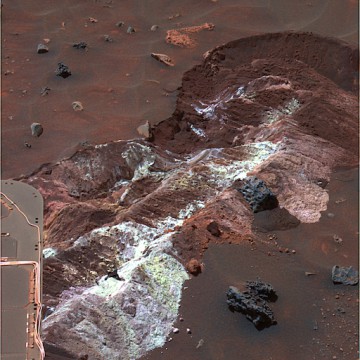
The Spirit rover may have finished its journey a long time ago, but there is still plenty of data to go through and analyze, and continued study of that data has provided more evidence for one of the rover’s most significant findings: ancient hot springs in this area inside Gusev crater. Hot springs, as on Earth, would also have provided a potentially habitable environment for any Martian microorganisms, as well as being ideal for preserving fossils of such organisms if they existed.

The new results were announced last week at the 2015 Lunar and Planetary Science Conference (LPSC) in The Woodlands, Texas. Preliminary evidence for hot springs had been found before, close to the Home Plate rock outcrop. The new data builds on that and supports those earlier findings that hot springs or fumaroles were once active in this region. This is also of potential biological interest, of course, since hot springs on Earth are teeming with microbial life.
Even though it would be millions or billions of years ago when these hot springs were last active, they add to the evidence for an earlier time on Mars where conditions would have been more favorable for life.
The evidence comes from the mineralogical composition of the soil and rock outcrops that Spirit examined in this area. They were found to consist largely of opaline silica. Along with other clues, scientists recognized this as resulting from an ancient hydrothermal system. Analysis of stratigraphic and textural characteristics of the outcrops also supported the hypothesis of a hot spring or geyser-related origin.
However, some unusual nodule features were difficult to explain. But now, new observations of very similar features, silica sinter deposits, at El Tatio, Chile, have helped scientists to figure out that the Martian features seen by Spirit were also the result of hot spring activity in the planet’s past. On Earth, microbes are also entombed in the silica, showing that this area on Mars could have had high habitability and preservation potential. If any microscopic organisms were ever present, they might still be fossilized there.
The silica formations near Home Plate on Mars appear as clusters of nodular rocks with very irregular surfaces, described generically as digitate protrusions. At first they were thought to be due to aeolian erosion processes alone, but terrestrial examples of certain hot spring silica sinter deposits showed that these kinds of features can form directly through precipitation of silica from solutions.

The nodular protrusions are produced by the shallow discharge channels at El Tatio, which support a wide variety of microbial life forms. These hot spring discharge channels produce sinter that is the most morphologically similar to the Home Plate silica. At El Tatio, the silica features are formed in shallow channels and overland flows, in channels with flowing water and on pool margins. The similarities to the Home Plate features suggest a similar environment in Mars’ ancient past.
The new paper states in conclusion:
“The columnar sinters that form nodular clusters in shallow hot spring discharge channels at El Tatio provide a remarkable analog to the forms of silica observed adjacent to Home Plate, making a strong case for a comparable setting on Mars. At El Tatio, such settings favor the growth and preservation of microbes, thus the Home Plate silica deposits are an ideal location for searching for past life on Mars.”

Spirit had also found other evidence for past hydrothermal activity … by accident. When its right-front wheel stopped turning, the dragging wheel churned up the soil, revealing bright, extensive deposits of salty minerals, which also pointed to past hot water chemistry. Those findings were tantalizing, although not conclusive; taken together with the silica sinter deposits and other evidence, however, a compelling case is made that this region used to be much more active a long time ago, and was a habitable environment by earthly standards.
There was also a small pointy hill near Home Plate which some scientists had suggested might be a type of cinder cone. Unfortunately, Spirit never made it there, although was heading toward it, after becoming stuck in the sand near Home Plate, and unable to extract itself. There have even been suggestions that Home Plate itself is the remnant of a former larger cinder cone/mini-volcano. Such an interpretation would fit in nicely with the other hydrothermal evidence in this area.
Spirit landed in Gusev crater on Mars on Jan. 4, 2004, and continued exploring until it was last heard from on March 22, 2010. Gusev crater was thought to have once been an ancient lake. While little evidence for that was found on the crater floor itself, plenty of evidence for past water activity, including the hot springs, was found in the hills near the landing site.
Elsewhere in the Solar System, evidence for current hydrothermal activity was also just recently announced regarding Saturn’s geyser moon Enceladus, where vents similar to “smokers” on Earth are now thought to exist on the seafloor of this tiny but active moon.
Spirit may no longer be active, but future missions could examine similar features to these more closely. Perhaps—just perhaps—as on Earth, there might even be fossilized traces of microbes waiting to be found, which used to call these ancient Martian hot springs home. Spirit may be gone, but it has left a treasure trove of data still to be examined, providing valuable clues to Mars’ ancient history and habitability.
Want to keep up-to-date with all things space? Be sure to “Like” AmericaSpace on Facebook and follow us on Twitter: @AmericaSpace




This evidence further supports the likely commonality of habitable regions with our Solar system as well as throughout the universe. Exploration must continue.